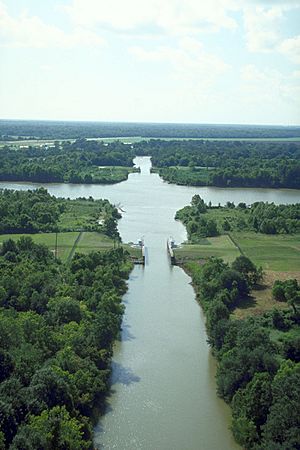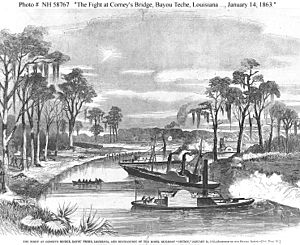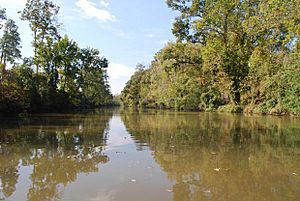Bayou Teche facts for kids
The Bayou Teche is a long waterway in south central Louisiana, United States. It's about 125-mile-long (201 km) and is very important to the culture of the area. Thousands of years ago, the Bayou Teche was actually the main path of the Mississippi River. Over time, the Mississippi River naturally changed its course, leaving the Teche as a separate bayou. This happened because the river's deposits of silt and sediment built up, causing the river to find new paths.

Contents
History of Bayou Teche
The Teche begins in Port Barre. Here, it gets water from Bayou Courtableau. It then flows south until it meets the Lower Atchafalaya River at Patterson. When the Acadian people first moved to this area, which was then called the Attakapas region, the Teche was the main way they traveled.
Bayou Teche During the Civil War
During the American Civil War, there were two important battles on Bayou Teche involving gunboats. Gunboats are small armed ships.
The first battle happened from November 3-5, 1862. Four Union gunboats, the USS Kinsman, USS Calhoun, USS Estrella, and USS Diana, sailed up the Teche. They faced a Confederate gunboat called the CSS J. A. Cotton near Cornay's Bridge. The J. A. Cotton was a steamboat that had been made stronger with wood and cotton bales. Even though it was hit several times, the Cotton was not badly damaged. Over the next two days, the Cotton won two more fights. Later, the Union ships captured two other Confederate steamers.
The second battle took place on January 14, 1863. Union General Godfrey Weitzel learned that the J. A. Cotton was planning an attack. So, the same Union gunboats sailed into the Bayou again. The bayou had been blocked with tree branches and other things. The Union gunboats and soldiers on land fought against the J. A. Cotton and Confederate soldiers. During this battle, the Kinsman hit a mine and was damaged. The J. A. Cotton was also badly damaged. Its crew set it on fire that night so the Union forces couldn't capture it. However, the Union army could not keep control of the Teche. This meant they had to invade the area two more times in 1863 and 1864.
Eventually, the Union forces took control of the Bayou Teche and Atchafalaya River area. Historian John D. Winters wrote that Union troops collected many horses, mules, and sugar. Plantation owners who stayed in the area agreed to support the U.S. government. They were then allowed to make agreements with the formerly enslaved people to finish harvesting their sugar crops.
Modern Changes to the Teche
After levees (walls to hold back water) were built along the Atchafalaya River in the 1930s, the Teche and the rice farms along it didn't get as much fresh water. To fix this, the United States Army Corps of Engineers built a pumping station between 1976 and 1982. This station, located at Krotz Springs, pumps water from the Atchafalaya River into Bayou Courtableau, which then flows into the Teche.
What's in a Name?
The exact meaning of the name "Teche" is not fully known. One idea is that it comes from "tenche," a word from the Chitimacha Indian language. This word means "snake." It might refer to how the bayou twists and turns like a snake. The Chitimacha people have an old story about a giant snake that attacked their villages. Many warriors fought for years to kill it. Where the huge snake's body lay and broke down, the ground sank. This depression then filled with water to become the bayou.
Another idea, from George R. Stewart, is that "Teche" might be a French way of saying "Deutsch." This was the name that German settlers in the area might have given to their stream.
Interesting Facts About the Teche
The southern author Harnett Kane wrote a book called The Bayous of Louisiana (1943). In it, he called the Teche "The Opulent Teche" and said it was "the most handsomely endowed of the bayous." This means he thought it was the most beautiful and rich of the bayous.
A sugar plantation called Lagonda was built on Bayou Teche by Lewis Strong Clarke. He was also involved in Republican politics in the late 1800s.
Towns Along Bayou Teche
Many towns are located along the Bayou Teche, including:
- St. Landry Parish, Louisiana
- St. Martin Parish, Louisiana
- Iberia Parish, Louisiana
- Loreauville, Louisiana
- Morbihan, Louisiana
- New Iberia, Louisiana
- Jeanerette, Louisiana
- St. Mary Parish, Louisiana
Images for kids




